

 中文摘要:
中文摘要:
员工导向与顾客导向是组织导向的重要内容,但已有研究发现二者存在潜在冲突。文章试图在利益相关者理论框架下,引入员工承诺和顾客满意两类关键变量,探索员工与顾客的价值统一性,以发展员工导向与顾客导向的整合机制。运用来自我国服务型企业的研究数据分析发现,员工导向与顾客导向能够在员工承诺和顾客满意的联结作用下有效整合,并共同推动企业市场效能的提升。同时,实证结论还显示,传统服务型企业和高端服务型企业的组织导向整合机制存在显著差异性。最后,文章对研究结论的理论与实践启示,以及存在的局限性进行讨论。
 英文摘要:
英文摘要:
Employee orientation (EO) and customer orientation (CO) are the main contents of organization orientation. How-ever, existing research pointed out there were some potential conflicts among them. This study, under the framework of stakeholder theory, attempts to integrate the EO and CO by introducing two types of key variables of the employee commitment (EC) and cus- tomer satisfaction (CS). The conclusions, using the empirical data from service enterprises, show that the EO and CO could be ef- fectively integrated, and jointly boost the market efficiency under the binding functions of the EC and CS. Meanwhile, there are some differences in integration mechanism between traditional service enterprises and high-end service enterprises. Finally, the theo-retical revelations and managerial implications of the conclusions, as well as the limitations of this study are discussed.
 同期刊论文项目
同期刊论文项目
 同项目期刊论文
同项目期刊论文
 期刊信息
期刊信息
